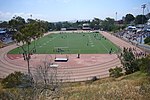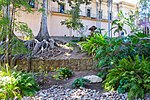Naval Medical Center San Diego
1917 establishments in CaliforniaBalboa Park (San Diego)Hospital buildings completed in 1925Hospitals in San DiegoMedical installations of the United States Navy ... and 3 more
Military facilities in San Diego County, CaliforniaMilitary hospitals in the United StatesMilitary in San Diego
Naval Medical Center San Diego (NMCSD), also known as Bob Wilson Naval Hospital and informally referred to as "Balboa Hospital", or “The Pink Palace” is a technologically advanced Navy medical treatment facility. Located within the grounds of Balboa Park in San Diego, the hospital has played a role in the history of San Diego for more than 100 years. The goal has remained constant, to provide the finest medical care in a family-centered care environment to operational forces, their families, and veterans. Organizationally, the hospital is first and foremost a military command.
Excerpt from the Wikipedia article Naval Medical Center San Diego (License: CC BY-SA 3.0, Authors).Naval Medical Center San Diego
Bob Wilson Drive, San Diego
Geographical coordinates (GPS) Address Phone number Website External links Nearby Places Show on map
Geographical coordinates (GPS)
| Latitude | Longitude |
|---|---|
| N 32.725 ° | E -117.14583333333 ° |
Address
Naval Medical Center San Diego
Bob Wilson Drive 34800
92101 San Diego
California, United States
Open on Google Maps








